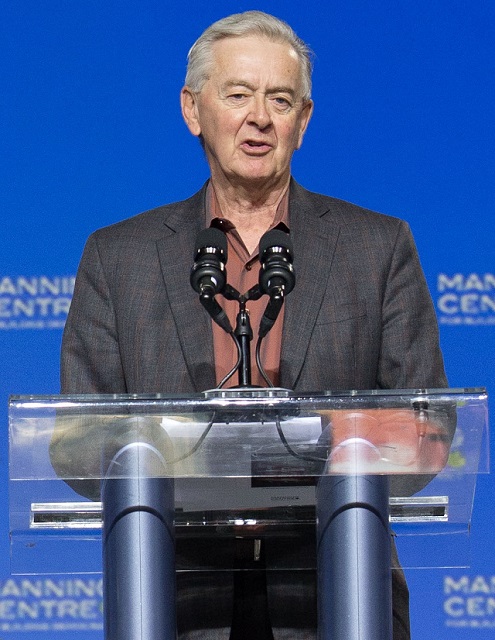Alberta
Never again! Preston Manning review recommends Emergency Management Agency co-ordinate response to future province-wide public emergencies.

Emergency Review Panel Releases Final COVID-19 Report and Recommendations for the Alberta Government
The Public Health Emergencies Governance Review Panel, led by Preston Manning, delivered its final report to the Government of Alberta, which includes over 90 recommendations for consideration.
The Panel was tasked by Premier Danielle Smith with undertaking a detailed review of the legislation and governance employed during the COVID-19 crisis, and to recommend changes and additional legislation to better prepare the province to meet future public emergencies. The mandate of the Panel was not to conduct an overall inquiry into the government’s response to COVID-19, but strictly to review the statutes that provided the legal basis for the government’s response to COVID-19.
Drawing upon the expertise and research of advisors and contractors commissioned for the study, the Panel arrived at a series of conclusions and recommendations for the Alberta Government to consider.
The recommendations of the Panel fall into three main categories, and included:
- Improving the focus and performance of the administrative and regulatory framework used to respond to provincewide public emergencies, including:
- Strengthen the Alberta Emergency Management Agency (AEMA) through legislative amendments and budgetary provisions to make it the lead government agency responding to and coordinating the response of the Alberta government to future provincewide public emergencies, including health emergencies.
- Develop and maintain a broadly-based Inventory of Scientific Advice and Scientific Advisors that can be drawn upon in the event of a public emergency.
- Mandate by legislation that preliminary, interim and post-emergency impact assessments be conducted in response to any future provincewide public emergencies.
- Reject provincewide school closures as a policy option in responding to a provincewide public emergency, except in the most exceptional of circumstances, and then only for the shortest possible period of time.
- Balancing the protection of Albertans from the harms caused by public emergencies with the protection of their basic rights and freedoms during an emergency period, including:
- Amend the Alberta Bill of Rights and Alberta’s Employment Standards Code and Health Professions Act to protect the rights and freedoms of all Albertans, including workers and healthcare professionals, and the freedom of expression during public emergencies.
- Increasing the overall capacity of Alberta’s healthcare system to respond to surges in demand caused by a public health emergency. Here, the Panel recognized that the government has already taken numerous incremental steps to increase the overall capacity of the healthcare system. The Panel commends those initiatives and recommends additional incremental steps, all compatible with the principles of universality and the Canada Health Act, including:
- Expanding the use of nurse practitioners and licensed practical nurses.
- Reducing or eliminating barriers to labour mobility for healthcare workers.
- Exploring options for attracting more healthcare providers into medical training
- Incentivizing medical graduates to serve in the most needed areas.
- Utilizing pharmacists to their full scope of practice.
- Expanding and improving the organization of home care services.
- Expanding the capacity of the Alberta healthcare system to deal with mental health.
- Expanding and supporting the use of virtual medicine and telemedicine.
- Streamlining system administration.
The panelists include Michel Kelly-Gagnon (President Emeritus of the Montréal Economic Institute), The Honourable John C. (Jack) Major CC KC (Former Supreme Court of Canada Justice), Preston Manning, PC CC AOE (former MP for Calgary Southwest and Leader of the Opposition in the House of Commons), Dr. Jack Mintz (president’s fellow of the School of Public Policy at the University of Calgary and a distinguished senior fellow of the MacDonald-Laurier Institute), Dr. Martha Fulford (Infectious Disease Specialist and Retired Chief of Medicine, McMaster University), and Dr. Robert Tanguay, Psychiatrist and Clinical Assistant Professor of Psychiatry and Surgery at the Cumming School of Medicine).
Quotes
“The COVID-19 pandemic and resulting global turmoil was unprecedented. Alberta, like the rest of the world, had to make decisions quickly and with limited, changing and even conflicting information. It is my hope that by adopting these recommendations, the Government will be better equipped to cope with future emergencies, and that the impacts on Albertans – their personal livelihoods, civil liberties, and mental health can be mitigated to the greatest extent possible.” – Preston Manning, Chair
“For the credibility of the study and our final recommendations, I felt it was important to select panelists and advisors with varied areas of expertise and perspectives on the key issues. For that reason, while there were certainly differences of opinion, I am thrilled that we were ultimately able to arrive at a consensus on the recommendations put forward.” – Preston Manning, Chair
Read the full report here.
Most Important Conclusions/Recommendation Per Chapter
- Strengthen, through legislative amendments and budgetary provisions, the Alberta Emergency Management Agency (AEMA) – whose members are specifically trained in emergency management – to make it the lead government agency for co-ordinating the response of the Alberta government to any and all future provincewide public emergencies. (Chapter 2)
- Appoint a Senior Science Officer, with multidisciplinary training and experience, to the AEMA, responsible for developing and maintaining a broadly based Inventory of Scientific Advice and Scientific Advisors that can be drawn upon in the event of public emergencies. (Chapter 3)
- Increase the effectiveness and accountability of the Alberta regulatory framework by increasing its evidence- based decision-making capacity, transparency, consistency, fairness, and self-correctability via feedback. (Chapter 4)
- Reject provincewide school closures as a policy option in responding to a provincewide public emergency, except in the most exceptional of circumstances and only then for the shortest possible period of time. (Chapter 5)
- Mandate by legislation the conduct of impact assessments prior to, during and after promulgation of orders and regulations for adoption in response to a declared provincewide public emergency. (Chapter 6)
- Recognize that public emergencies generate additional and exceptional pressures on governments to limit the exercise of rights and freedoms, and thus amend theAlberta Bill of Rights to specifically strengthen the protection of rights and freedoms under such circumstances. (Chapter 7)
- Increase the protection of the rights and freedoms of workers and healthcare professionals, during public emergencies, in particular their freedom of expression, through amendments to Alberta’s Employment Standards Code and Health Professions Act. (Chapter 8)
- Increase the overall capacity of the Alberta healthcare system, thereby increasing its capacity to meet surges in demand caused by public health emergencies, through the incremental measures proposed, while respecting the principle of universality and the provisions of the Canada Health Act. (Chapter 9)
- On the belief that Alberta can always learn from others, invite representatives from countries having healthcare systems that outperform Canada/Alberta to a Colloquium on 21st Century Healthcare Best Practices to identify the policies, legislation and features of their systems responsible for superior performance. (Chapter 9)
- The recommendations of this report are based on the general consensus of Panel members as to how best to prepare Alberta to cope with future public emergencies. But “preparing for future public emergencies” is an evolving process, subject to unforeseen factors and considerations. Therefore, alternative perspectives and narratives on how to best cope with future emergencies should also be welcomed, appreciated and examined.
Alberta
Danielle Smith slams Skate Canada for stopping events in Alberta over ban on men in women’s sports

From LifeSiteNews
The Alberta premier has denounced Skate Canada as ‘disgraceful’ for refusing to host events in the province because of a ban on ‘transgender’ men in women’s sports.
Alberta Premier Danielle Smith has demanded an apology after Skate Canada refused to continue holding events in Alberta.
In a December 16 post on X, Smith denounced Skate Canada’s recent decision to stop holding competitions in Alberta due to a provincial law keeping gender-confused men from competing in women’s sports.
“Women and girls have the right to play competitive sports in a safe and fair environment against other biological females,” Smith declared. “This view is held by a vast majority of Albertans and Canadians. It is also common sense and common decency.”
Women and girls have the right to play competitive sports in a safe and fair environment against other biological females.
This view is held by a vast majority of Albertans and Canadians. It is also common sense and common decency.
Skate Canada‘s refusal to hold events in… pic.twitter.com/n4vbkTx6B0
— Danielle Smith (@ABDanielleSmith) December 16, 2025
“Skate Canada‘s refusal to hold events in Alberta because we choose to protect women and girls in sport is disgraceful,” she declared.
“We expect they will apologize and adjust their policies once they realize they are not only compromising the fairness and safety of their athletes, but are also offside with the international community, including the International Olympic Committee, which is moving in the same direction as Alberta,” Smith continued.
Earlier this week, Skate Canada announced their decision in a statement to CBC News, saying, “Following a careful assessment of Alberta’s Fairness and Safety in Sport Act, Skate Canada has determined that we are unable to host events in the province while maintaining our national standards for safe and inclusive sport.”
Under Alberta’s Fairness and Safety in Sport Act, passed last December, biological men who claim to be women are prevented from competing in women’s sports.
Notably, Skate Canada’s statement failed to address safety and fairness concerns for women who are forced to compete against stronger, and sometimes violent, male competitors who claim to be women.
Under their 2023 policy, Skate Canada states “skaters in domestic events sanctioned by Skate Canada who identify as trans are able to participate in the gender category in which they identify.”
While Skate Canada maintains that gender-confused men should compete against women, the International Olympic Committee is reportedly moving to ban gender-confused men from women’s Olympic sports.
The move comes after studies have repeatedly revealed what almost everyone already knew was true, namely that males have a considerable innate advantage over women in athletics.
Indeed, a recent study published in Sports Medicine found that a year of “transgender” hormone drugs results in “very modest changes” in the inherent strength advantages of men.
Additionally, male athletes competing in women’s sports are known to be violent, especially toward female athletes who oppose their dominance in women’s sports.
Last August, Albertan male powerlifter “Anne” Andres was suspended for six months after a slew of death threats and harassments against his female competitors.
In February, Andres ranted about why men should be able to compete in women’s competitions, calling for “the Ontario lifter” who opposes this, apparently referring to powerlifter April Hutchinson, to “die painfully.”
Interestingly, while Andres was suspended for six months for issuing death threats, Hutchinson was suspended for two years after publicly condemning him for stealing victories from women and then mocking his female competitors on social media. Her suspension was later reduced to a year.
Alberta
Alberta’s huge oil sands reserves dwarf U.S. shale

From the Canadian Energy Centre
By Will Gibson
Oil sands could maintain current production rates for more than 140 years
Investor interest in Canadian oil producers, primarily in the Alberta oil sands, has picked up, and not only because of expanded export capacity from the Trans Mountain pipeline.
Enverus Intelligence Research says the real draw — and a major factor behind oil sands equities outperforming U.S. peers by about 40 per cent since January 2024 — is the resource Trans Mountain helps unlock.
Alberta’s oil sands contain 167 billion barrels of reserves, nearly four times the volume in the United States.
Today’s oil sands operators hold more than twice the available high-quality resources compared to U.S. shale producers, Enverus reports.
“It’s a huge number — 167 billion barrels — when Alberta only produces about three million barrels a day right now,” said Mike Verney, executive vice-president at McDaniel & Associates, which earlier this year updated the province’s oil and gas reserves on behalf of the Alberta Energy Regulator.
Already fourth in the world, the assessment found Alberta’s oil reserves increased by seven billion barrels.
Verney said the rise in reserves despite record production is in part a result of improved processes and technology.
“Oil sands companies can produce for decades at the same economic threshold as they do today. That’s a great place to be,” said Michael Berger, a senior analyst with Enverus.
BMO Capital Markets estimates that Alberta’s oil sands reserves could maintain current production rates for more than 140 years.
The long-term picture looks different south of the border.
The U.S. Energy Information Administration projects that American production will peak before 2030 and enter a long period of decline.
Having a lasting stable source of supply is important as world oil demand is expected to remain strong for decades to come.
This is particularly true in Asia, the target market for oil exports off Canada’s West Coast.
The International Energy Agency (IEA) projects oil demand in the Asia-Pacific region will go from 35 million barrels per day in 2024 to 41 million barrels per day in 2050.
The growing appeal of Alberta oil in Asian markets shows up not only in expanded Trans Mountain shipments, but also in Canadian crude being “re-exported” from U.S. Gulf Coast terminals.
According to RBN Energy, Asian buyers – primarily in China – are now the main non-U.S. buyers from Trans Mountain, while India dominates purchases of re-exports from the U.S. Gulf Coast. .
BMO said the oil sands offers advantages both in steady supply and lower overall environmental impacts.
“Not only is the resulting stability ideally suited to backfill anticipated declines in world oil supply, but the long-term physical footprint may also be meaningfully lower given large-scale concentrated emissions, high water recycling rates and low well declines,” BMO analysts said.
-

 Alberta7 hours ago
Alberta7 hours agoDanielle Smith slams Skate Canada for stopping events in Alberta over ban on men in women’s sports
-

 Health24 hours ago
Health24 hours agoSaskatchewan woman approved for euthanasia urged to seek medical help in Canada rather than US
-

 Indigenous23 hours ago
Indigenous23 hours agoResidential school burials controversy continues to fuel wave of church arsons, new data suggests
-

 Health1 day ago
Health1 day agoCanadian gov’t considers sharing census data on gender-confused children
-

 International23 hours ago
International23 hours agoFBI didn’t think it had cause to raid Trump but DOJ did it anyway
-

 Crime2 days ago
Crime2 days agoTrump designates fentanyl a ‘weapon of mass destruction’
-

 Energy12 hours ago
Energy12 hours agoLiberals Twisted Themselves Into Pretzels Over Their Own Pipeline MOU
-

 Digital ID2 days ago
Digital ID2 days agoCanada releases new digital ID app for personal documents despite privacy concerns




